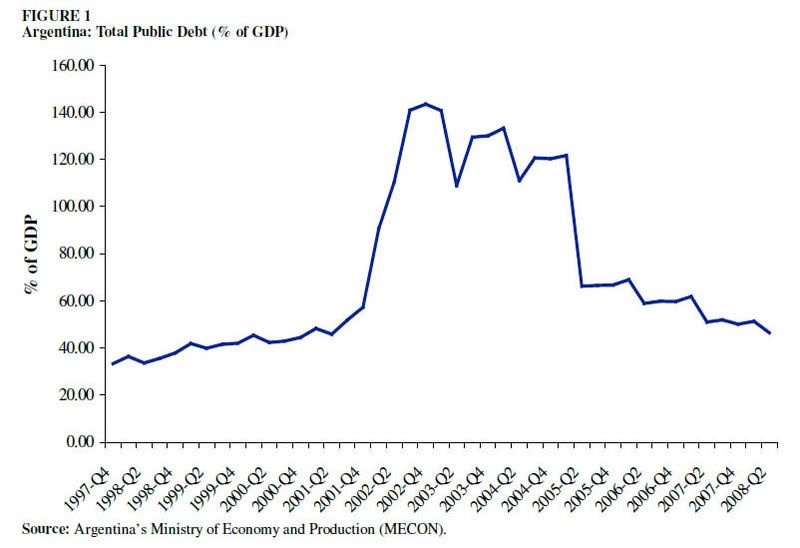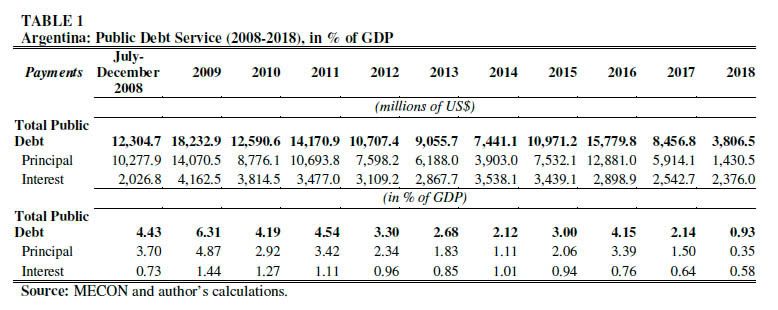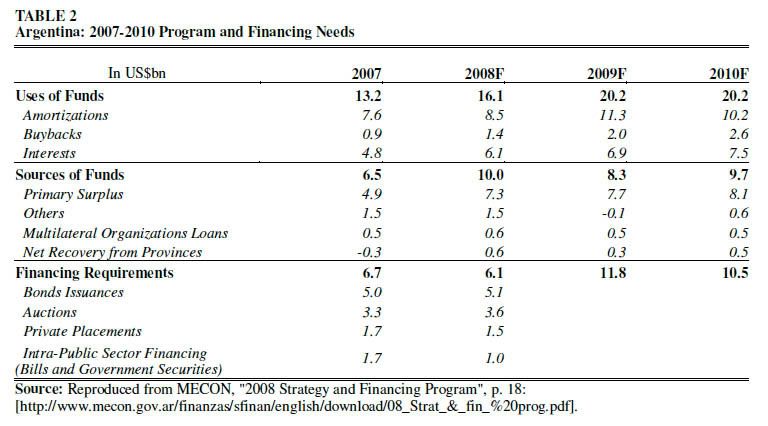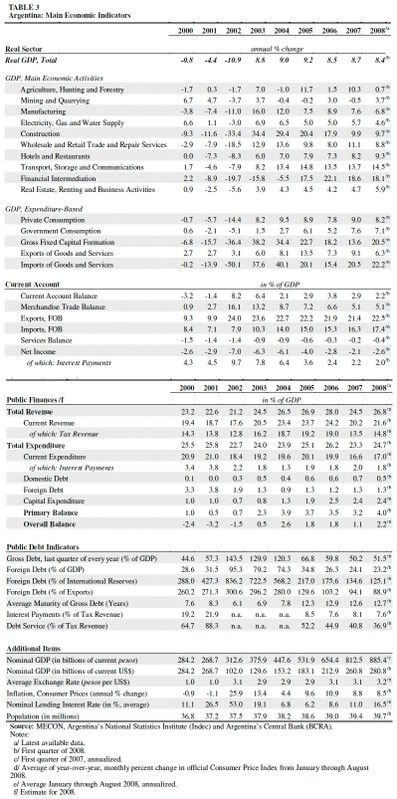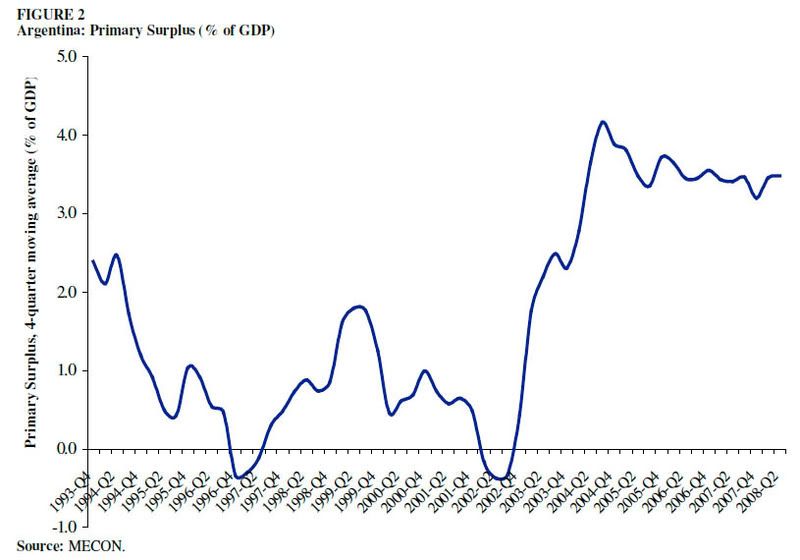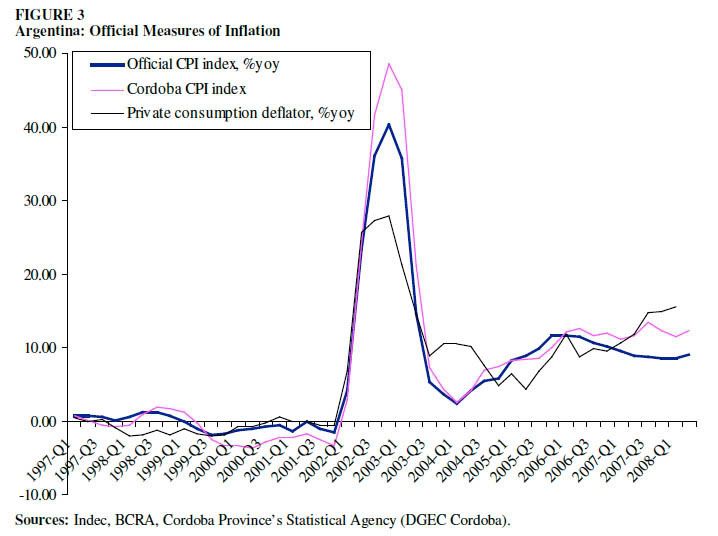In recent weeks there have been numerous press reports and articles indicating that Argentina is facing serious economic problems that could lead to a default on its sovereign debt. Some of these analyses compare Argentina’s current situation to that of 2001, when the government of Argentina did actually default.1
It is not only journalists and financial analysts that have expressed such views. From July 22 to August 7, before the recent financial market turmoil sent emerging market bond country risk premiums sharply higher, Argentina’s five-year credit default swap rate rose by 186 basis points. This means that the cost of insuring $10 million of Argentine bonds rose from $639,000 to $825,000.
This report will look briefly at Argentina’s current debt, fiscal, and overall economic situation to see if such analyses are justified. It appears that there is little or no basis for the fear that Argentina might default on its sovereign debt at any time in the foreseeable future, or indeed even the more distant future.
Argentina’s Debt Burden
Figure 1 shows Argentina’s total public debt as a percentage of GDP. As can be seen in the graph, it peaked at 143.5 percent of GDP during the economic crisis of 2002, in the fourth quarter, and, despite some ups and downs prior to 2005, has declined to 51.5 percent today. The steepest drop was in the second quarter of 2005, when the debt fell from 121.7 percent to 66.2 percent of GDP as a result of the debt restructuring. Nonetheless it has fallen steadily since then, to its current level of 51.5 percent of GDP.2
Clearly the government is not facing a rising or unusually high debt relative to GDP; rather it is falling.
What about the burden of debt service in coming years? This is shown in Table 1. As can be seen, the interest payments on the debt are relatively modest, about 1.5 percent of GDP for 2008, and 1.4 percent of GDP for 2009, and then declining thereafter.
Principal payments are larger: 3.7 percent of GDP for the second half of this year, also peaking in 2009 at 4.9 percent of GDP, then declining. Normally, when there is a lump in principal payments, as in this case, it can be smoothed out by rolling some of it over. However, Argentina defaulted on its sovereign debt in 2001, and foreign creditors holding some 24 percent (19.3 billion) of the restructured debt did not agree to the debt restructuring that took place in 2005. As a result, there are pending legal actions from the holdout creditors that prevent the government from accessing most international credit markets.
However, there is no reason to believe that the Argentine government will have trouble making all of its debt payments in these next two years, including principal payments.
Table 2 shows the Argentine government’s financing strategy as of April 2008. As can be seen, total debt service, including $2 billion of debt buybacks, for 2009 will increase to $20.2 billion from $16.1 billion for 2008. Some $8.3 billion of the money is projected to be available, most of it ($7.7 billon or 2.7 percent of GDP) coming from the federal government’s primary budget surplus.
This leaves a financing gap of $11.8 billion. It is worth noting that the government is assuming just 4 percent real GDP growth for 2009, as compared to the current growth of about 8 percent annually.
In their most recent (August 26) analysis of Argentina’s debt, Morgan Stanley also takes $20.2 billion for the starting point of total debt service for 2009.3 However, they note that $5.5 billion of this is likely to be rolled over without problems, leaving only $14.7 billion to be financed. Of this, they project a primary surplus of $8.7 billion. They project $1.8 – $3 billion to be financed from pension funds, and take the lower number; and $2.1 billion from a reduction in the rate of growth of energy subsidies.
This would leave Argentina with only $2.1 billion to cover from either borrowing from Venezuela — as it has done in recent years — or financing from savings or reserves. Morgan Stanley estimates that the Argentine government has at least $6-7 billion in savings, in addition to $47 billion in reserves. Even taking into account that the government has now decided to pay off its $6.7 billion debt to the Paris Club,4 this is quite a bit of savings and reserves relative to any potential shortfall.5
The Morgan Stanley analysis assumes 4.7 percent growth for next year and another 30 percent decline in the price of soybeans, a major export and sources of tax revenue. They note that there are other possible scenarios which would leave the government with a shortfall bigger than the $2.1 billion that they consider likely.
But the bottom line is that any shortfall in 2009 is going to be very small relative to the combination of the government’s savings and excess international reserves at the Central Bank. It is very difficult to imagine a situation in which there would be a problem in servicing the debt, and default would appear to be out of the question.
Beyond 2009, Argentina’s debt service as a percent of GDP falls significantly and steadily. This can be seen in Table 1. It falls from 6.31 percent of GDP in 2009, to 4.19 percent in 2010, then rises slightly 4.54 percent in 2011, and then declines steadily. It is clear that 2008 and 2009 are the “hump” years. There is no obvious trouble once these years have passed.
Trends in Debt, Debt Service, and the Economy
Table 3 shows other major indicators of public debt. As can be seen from the table, they have all been declining steadily since the huge drop that took place with the debt restructuring in 2005. Foreign public debt has declined from 34.8 percent of GDP in 2005 to 23.2 percent in 2008. During the same period, foreign public debt measured as a percentage of international reserves declined from 217 percent to 125.1 percent; and from 129.6 to 89.9 percent of export earnings. Debt service as a percentage of tax revenue also declined steadily from 52.2 to 36.9 percent.
These indicators show no evidence of a deteriorating debt situation; on the contrary, there has been steady improvement. The relevant economic indicators also do not show any sign of a looming correction that would dramatically alter the debt sustainability picture. The federal government budget currently has a primary surplus of 4.0 percent, and an overall surplus of 2.2 percent.
Figure 2 shows the quarterly primary fiscal surplus, plotted as a four-quarter moving average. As can be seen, there is no obvious downward trend in the last three years.
Argentina is also running a trade surplus of 5.1 percent of GDP and a current account surplus of 2.2 percent of GDP.
Inflation is a more difficult challenge, partly because the official figure for the Consumer Price Index (CPI) has been disputed, and is widely seen by economists as under-estimating inflation since January 2007. Figure 3 shows three official measures of inflation over the last decade: the official Consumer Price Index, based on price surveys in the Greater Buenos Aires area, which is currently running at 9.1 percent year-over-year (second quarter 2008); the consumer price index for Cordoba, which is at 12.2 percent year-over-year (second quarter 2008); and the private consumption deflator, which is currently at 15.6 percent (first quarter year-over-year).
However, economists outside the government have estimated consumer price inflation at about 24 percent this year, and this seems more reflective of actual price changes than the official Consumer Price Index6.
Some analysts have argued that the presumed underestimation of inflation demonstrates an unwillingness of the government to pay its debt, since some 41 percent of public debt has interest payments indexed to the official CPI. However, the under-estimation of inflation is not the same as an actual default on debt, and there is no indication that the latter is even close to being contemplated by the government. While it is important for a number of reasons to restore credibility to the official CPI, it does not follow that the risk of default on debt increases as a result of a lack of public confidence in the official measurement of inflation.
Conclusion
As can be seen from the data discussed above, there is little or no reason to expect that Argentina will default on its debt any time in the foreseeable future or beyond.
Comparisons to the Argentine economy of 2001 are even more unfounded. At that time, the economy was suffering through one of the worst recessions in Argentine history, and caught in a vicious spiral where it had to borrow at increasingly higher interest rates to support an overvalued exchange rate. Most importantly, the overvalued fixed exchange rate was a ticking time bomb; like the U.S. stock market bubble in the late 1990s or the housing bubble in the first half of the current decade, it was clear that a collapse was inevitable at some point. And of course Argentina’s currency collapse made its debt impossible to sustain.7 The Argentine economy today — which has grown more than 60 percent since its recovery began six years ago, has trade and current account surpluses, and has declining levels of debt relative to GDP and other indicators — has little in common with the situation of 2001.
It is worth noting that the consensus view of Argentina’s economy has been widely off the mark for most of the last decade. This can be seen in the International Monetary Fund (IMF)’s projections during the last recession, and then again in the recovery that followed. The IMF overestimated GDP growth for 2000, 2001, and 2002 by 2.3, 8.1, and 13.5 percentage points respectively, in its September World Economic Outlook forecast prior to each year.8 After the debt default at the end of 2001, the consensus view was that Argentina would suffer for years from lack of access to international financial markets and foreign investment. The IMF projections for the four years, 2003 through 2006 then came in low by 7.8, 5.0, 5.2, and 4.3 percentage points respectively. These forecast errors are enormous for the seven years noted, and among the largest consistent errors for the IMF in recent memory. Most economists and the business press were similarly wrong about the Argentine economy throughout most of the current economic expansion.
As Argentina’s debt burden declines after 2009, it will become clearer to the “holdout” bondholders that their continued efforts to block Argentina’s access to credit are not likely to have much impact on Argentina’s economy — they have had no apparent impact so far. It is therefore likely that this problem will also be resolved, and Argentina will regain normal access to international credit markets. But in any case, the current discussion of default possibilities has little or no basis in Argentina’s economic reality, current or projected.
1 See, for example, Drew Benson, “Kirchners Losing Argentina in Slump Leading to Crisis,” Bloomberg, September 2, 2008 (accessed online on October 2, 2008); and Aldo Abram and Martin Krause, “Deuda e inflación: Volver al futuro,” CIIMA-ESEADE, 2008: <www.eseade.edu.ar/ciima/articulos/deuda.pdf>.
2 Some reports have compared the present level of debt to that in 2001, just before the default, when it was 57.3 percent of GDP. However, this is not an appropriate comparison, because the exchange rate was so overvalued in 2001; as soon as the currency collapsed, the same debt in 2002 was 143.5 percent of GDP (see Table 3).
3 Gray Newman and Daniel Volberg, “Argentina. Default Fears,” Global Economic Forum, Morgan Stanley, August 26, 2008 (accessed online on October 2, 2008).
4 On September 2, the Argentine government announced that it was going to pay off its debt to the Paris Club, which totals $6.7 billion. (See, The Associated Press, “Argentina Will Pay US$6 Billion Paris Club Debt,” International Herald Tribune, September 3, 2008. Accessed online on September 26, 2008.) The timing of the payment was not announced.
5 There are currently legal restrictions on the government’s use of reserves at the Central Bank to pay off foreign debt. However, it is difficult to imagine that such constraints would be binding in a case where the reserves were necessary to avoid default.
6 See, for example, Miguel Bein and Marina Dal Poggeto (Estudio Bein), “Perspectivas para lo que resta del año,” in Ámbito Financiero, August 26, 2008 (accessed online on October 2, 2008); Ecolatina, “Informe Economico Semanal, No. 681,” September 5, 2008 (accessed online on October 2, 2008): <www.ecolatina.com/informes/IES%20681.pdf>; Prefinex, “Argentina Economic and Business Perspectives,” October 2008 (accessed online on October 2, 2008): <www.prefinex.com.ar/pdfs/AE&BP_2008-10_s.pdf>.
7 See footnote 2 above.
8 David Rosnick and Mark Weisbrot, “Political Forecasting? The IMF’s Flawed Growth Projections for Argentina and Venezuela,” Washington, DC.: Center for Economic and Policy Research, 2007 (accessed online on October 2, 2008).
Mark Weisbrot is Co-Director at the Center for Economic and Policy Research in Washington, DC. The author would like to thank Luis Sandoval and Rebecca Ray for research assistance, and also Roberto Frenkel and Dan Beeton for helpful comments.
|
| Print

